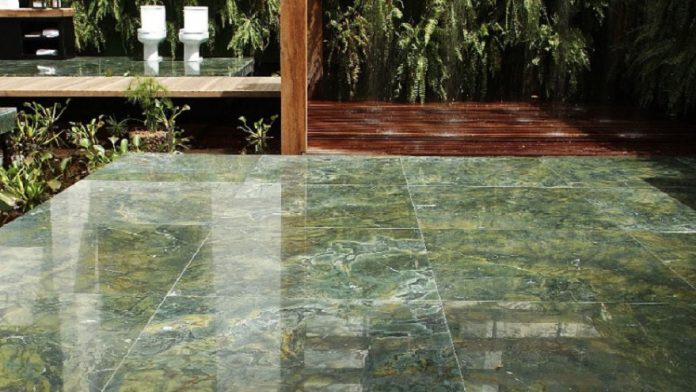The natural world wraps us in green, it’s an ever-present color of nature. But it’s not a common color among natural stones. That’s a shame, because green is expressive, easy on the eyes, and fun to design with. But fear not, Mother Nature didn’t totally forget green in her palette of stone colors. Some stones, like serpentine, are known for their verdant hues. While others, like soapstone and granite, have green variants that stand out from the earth-tone crowd. Let’s explore some green stones and illuminate their properties, minerals, and geologic origins.
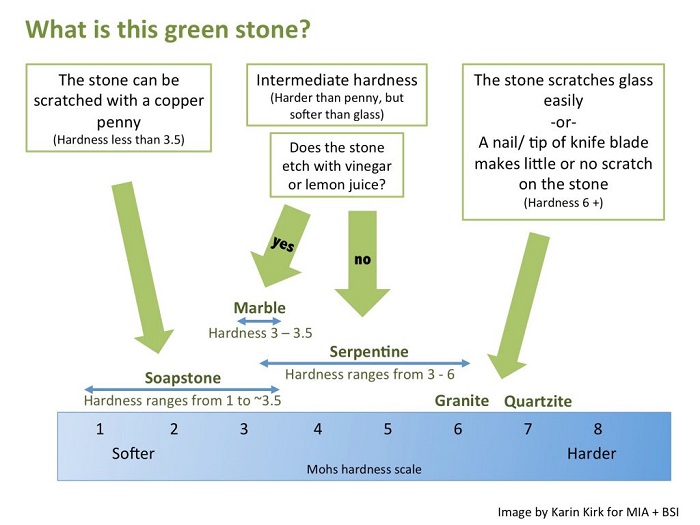
Serpentine
The green, mottled pattern and waxy feel of serpentine inspired its name – a reference to snakeskin. Serpentine can be a vibrant bright green, or a deep forest-green. It’s fine-grained and smooth, and it polishes to a satiny luster. Accents of brown, red, and white can liven up the stone with vivid movement, or it can have a serene aesthetic with gentle swirls of green and ivory.
While the distinctive look of serpentine makes it easy to spot, it’s one of those stones that can get a bit confused within the industry, leading to some conflicting information. Often serpentine is labeled as green marble, and sometimes it’s classified as “hard soapstone.” Alas, it’s neither. Unfortunately, serpentine can be a little tricky to identify because its hardness, color, and pattern can vary. That’s because serpentine isn’t one exact rock; it’s a family of stones that all form in a similar way, but can have slightly different minerals in them.
If you were to do a little Googling about serpentine, you’d discover phrases like, “Serpentinites form as a result of serpentinization.” Helpful, eh?
Thankfully, we can clarify that explanation. Serpentine (geologically known as serpentinite, but we’ll keep things simple here) is a metamorphic rock, which means it was first some other kind of rock and then experienced a change in conditions. The precursor to serpentine is an iron-rich magma that forms way underneath the ocean floor. In fact, this magma’s source is so deep that it comes from Earth’s mantle, many miles down in Earth’s interior. This deep, dense magma gives rise to the bright green mineral olivine, which is also known as peridot, August’s birthstone.
When this iron-rich, green stone mingles with hot seawater, new types of minerals are formed. This process is common, but it happens so deeply within the Earth’s crust that it’s rare to see it up here on the surface. But thanks to plate tectonics, deep rocks sometimes get shoved upwards, making geologists giddy for a glimpse of what’s happening far below our boots.
Because it’s made of a range of minerals, serpentine also has a range of hardness, between 3 and 6 on Mohs scale. That means it’s harder than marble but softer than granite. It’s a good idea to do a scratch test to investigate the hardness of the stone. This is best done with the tip of a sturdy pocketknife, an awl, or a steel nail. Make scratches in different parts of the slab to check the hardness of different colored areas, since those are made of different minerals.
Even though serpentine and marble have similar hardness, it’s easy to tell them apart. Marble will always become etched from contact with acids. Put a dribble of vinegar on the stone, let it sit for a few minutes, wipe off the vinegar, and inspect the stone for a change in coloration or a change in luster. If the stone is affected by acid, it’s marble. If not, it’s serpentine.
If the stone has white veins, it’s a good idea to do another acid test to see if the white parts of the stone etch when exposed to acid. Sometimes serpentine has white veins of calcite, but otherwise it should not be bothered by household acids.
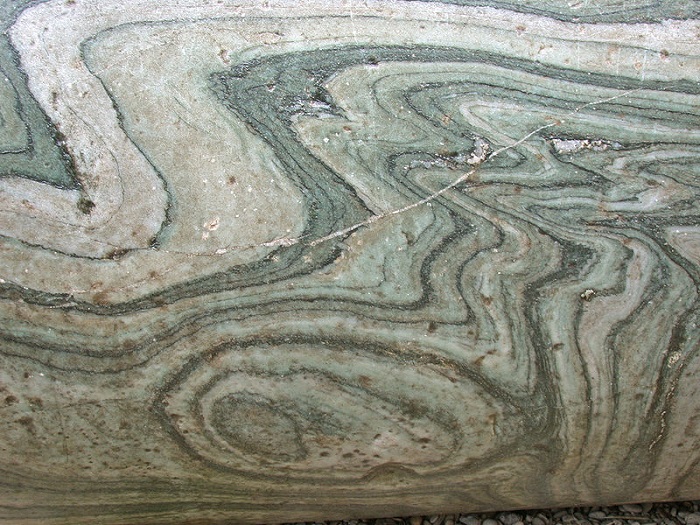
Soapstone
The world of natural stone could be divided into two categories: Those who cannot live without soapstone, and everyone else. Soapstone has a unique set of properties that set it apart from other stones and garner a devoted following. Acids, alkalines, heat, or cold don’t faze soapstone, as it shrugs off liquids, stains, and temperature extremes.
Alas, soapstone’s Achilles heel is that it’s relatively soft. Daily wear and tear on a kitchen countertop will take a visible toll on soapstone. That said, scratches can be sanded out or made less visible with a coating of oil. Another option is to simply use soapstone in easier-wearing situations, like a buffet, bar, or bathroom. Soapstone’s ability to absorb and re-radiate heat makes it an unrivaled material for wood stoves, fireplaces, or mantels.
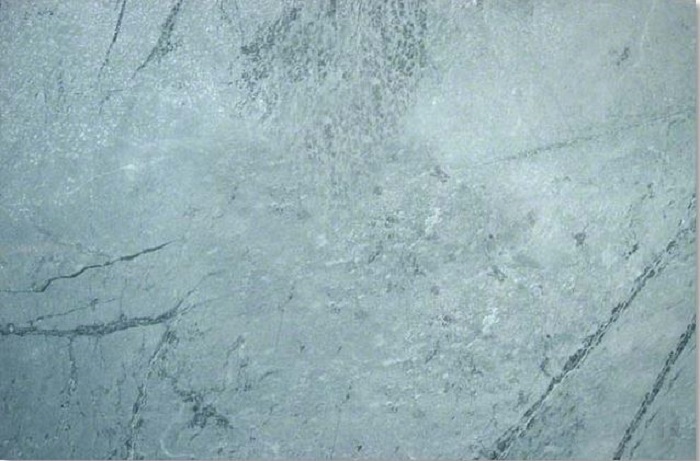
Soapstone can be deep green, grey, or black. It’s usually dissected by white veins in easygoing patterns. Not only is the stone itself soft, the whole aesthetic is too, with subtle color variations and a muted luster. This stone is equally suited for a Vermont farmhouse or a contemporary loft, lending timeless appeal to any style.
Talc is the primary ingredient in soapstone, but it’s not the only ingredient, and that’s why the hardness of soapstone varies. Talc is the softest of all minerals. It’s a member of the mica family, and it’s made of small flakes that are weakly bonded together. Thus, the mineral feels soapy because the tiny flakes slip and slide against each other when rubbed.
The greater the talc content, the softer the stone. Talc makes up 80% of soapstones used for carving, but the soapstone that’s used for countertops, fireplaces, tiles, and sinks contains only 30 to 50% talc. Soapstone owes its green color to the mineral chlorite, a deep green member of the mica family. Magnesite, amphibole, and other minerals round out the ingredient list. The hardest soapstones top out around 3 – 4 on Mohs hardness scale, which is similar to the hardness of marble. If it’s harder than that, it’s likely serpentine.
There’s good reason serpentine and soapstone are sometimes confused with each other. Not only do they look alike, they are closely related. Like serpentine, soapstone starts out as iron-rich magma deep underneath the ocean crust. Chemical reactions with hot seawater turn the stone to serpentine. If the stone undergoes further reactions with CO2-rich fluids, it changes to soapstone. These processes vary across small distances, and the chemistry behind it is a little crazy, so one can find a jumble of different rock types within a small area.
Green soapstones include Santa Rita and Majestic Green. Many distributors simply call it “green soapstone” rather than a specific name. Even if you don’t choose soapstone for your next project, be sure to stop and pet it next time you visit the slab yard. Its soft touch is irresistible!
Green Granite
If you pine for a green stone, but don’t want uncertainties in terms of hardness or durability, then green granite is your answer. While commercial granite is typically grey, ivory, brown, or black, it can sometimes be green too. There’s no single geologic explanation for green granites; they all have a different story behind their color.
Some green granites owe their coloration to less-common minerals, like Costa Esmeralda. Costa Esmeralda is a vibrant combination of apple-green epidote, along with the usual quartz and feldspar.
In other cases, green granite is caused by an uncommon color of a common mineral. Feldspars are the primary ingredients in granite and occasionally they can be green. For example, Peacock Green features a green feldspar called microcline, which is also known as the gemstone Amazonite.
Emerald Pearl (also called Labrador Emerald) is another granite that contains green feldspar. This stone is deep, dark green – almost black – with shimmering undertones that lend depth to a polished surface.
Labradorite is shiny, bright green thanks to an iridescent variation of feldspar called labradorite.
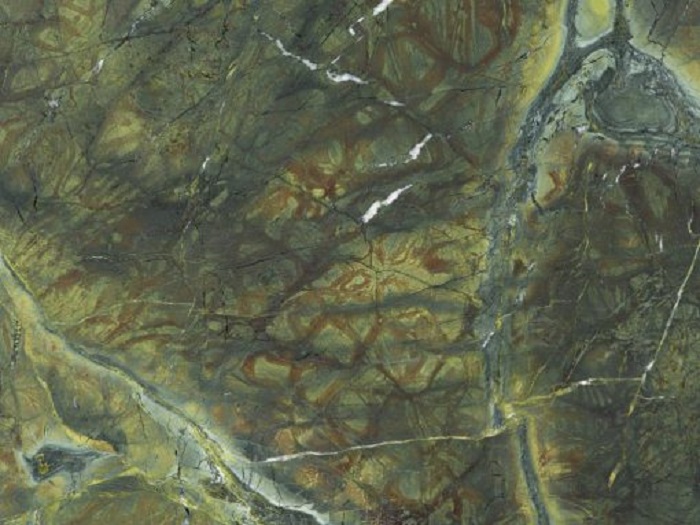
Vitoria Regia and Verde Tortuga are spectacular examples of ocean-floor lava flows. These stones are made of basalt, which turned slightly green through serpentinization (Heh, I got to sneak in that term, after all!). The hallmark of these stones is the circular or hexagonal pattern that takes shape as the lava cools.
Other green granites include Verde Butterfly, Ubatuba, Typhoon Green, Lapland Green, and Green Galaxy.
Is this still not enough green for you? You can also find green in quartzite (Sea Pearl), sandstone (Wild Sea), or slate (Unfading Green).
It might take a little extra sleuthing to find just the right green stone for your tastes, but the journey is worthwhile. If you’re keen for green, then no other color will do.
Source: usenaturalstone.org



